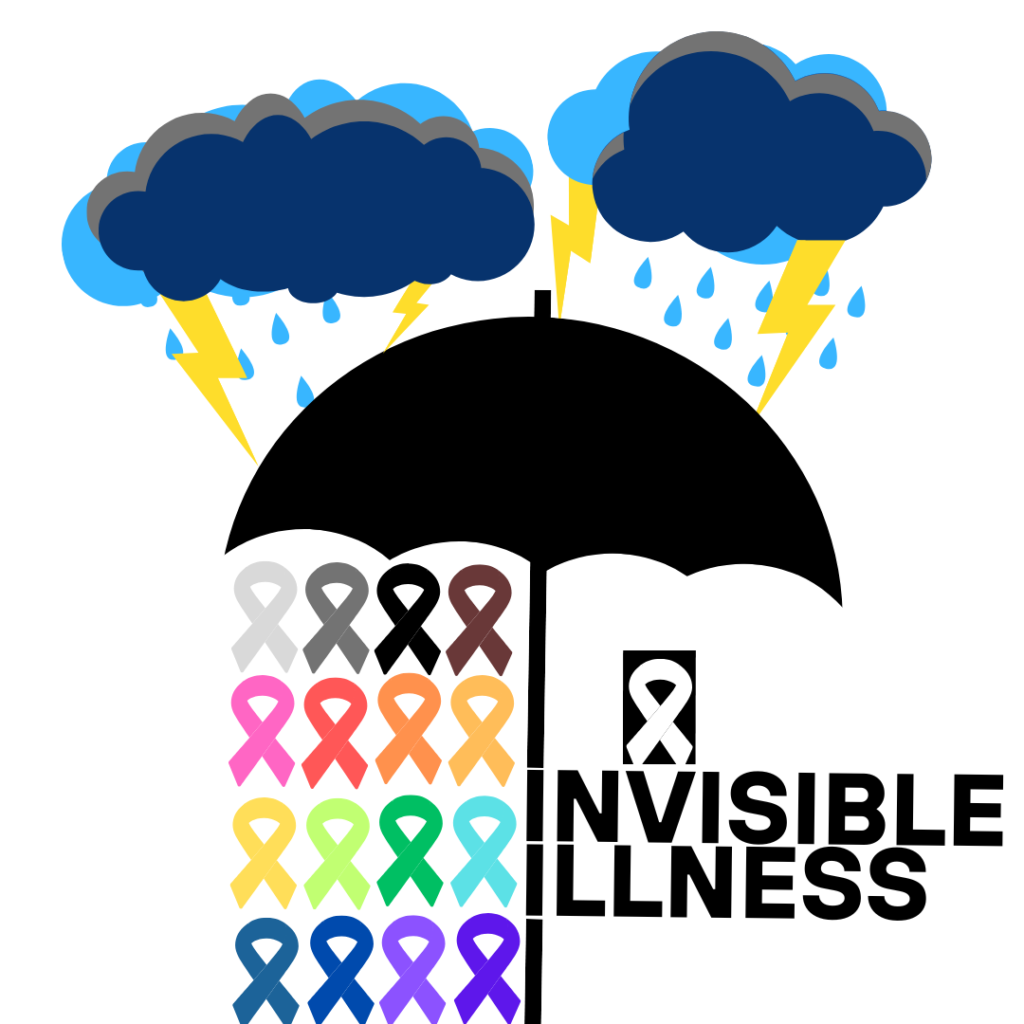Your cart is currently empty!
Bumble & Stinger Co.
Invisible & Chronic Illness Information
Bumble & Stinger Co.
Invisible but not fictional
Understanding Things You May Not See
Invisible Illness are present in a reported 10% of Americans.
According to Harvard Medical School, nearly 10% of Americans are living with a reported invisible illness. This number may be much greater, due to lack of proper diagnosis and reporting tools in the American healthcare system. Of those with a reported illness, only 6% use a visible aid for their disease(s)- coming from the American Medical Association Journal of Ethics. This means that a vast majority of those living with an invisible and chronic disease appear “seemingly” healthy and otherwise not living with a disability. Furthermore, alongside visible aids, many do not voice their need for environment modifications for their disease(s). This could range anywhere from requesting close captioning during a presentation at work to asking for a table close to the bathroom at a restaurant.
Visible Aid Examples: wheelchair, cane, walker, crutches, service animal, oxygen tanks, health monitors, wearable medical devices, hearing aids, or any other assistive device/technology.
“Having a Disability Does Not Always Mean You Are Disabled“
The Invisible Disabilities Association remarks that many living with challenges can still be fully active and present in many areas of their lives. The challenges of an illness do not automatically suggest the person is disabled. Additionally, a person using or not using an assistive device does not dictate if the person is disabled.
“But You Don’t Look Disabled”
There is always an opportunity to open a dialogue about invisible illnesses, but this phrasing is the fastest way to shut off that communication. Appearance (or lack thereof) of an illness does not constitute the legitimacy of the disease. If the symptoms and effects are real to the person experiencing them, then the illness is real.
“You’re Too Young for That”
Since when does age mean you are excluded from a health condition? Science is always evolving and new research is coming out every day about things we once thought we understood. There was once a time the accepted science was that the Earth was the center of our solar system! The World Health Organization (WHO) states: “A lack of knowledge, negative attitudes and discriminatory practices among healthcare workers, inaccessible health facilities and information and a lack of information or data collection/analysis all contribute to health inequities faced by this group” (those with disabilities).
Quick Numbers in American Healthcare
These numbers and statistics all come directly from certified reporting websites, like the CDC, CMS, NIH, WHO and AMA.
10%
Of Americans Live With a Reported Invisible Illness
$14,750
Average Spent Per Person Annually in the U.S. on Healthcare
90%
Of the Annual Healthcare Expenditures in America are for Chronic and Mental Health Conditions
Guidelines to Any Illness
Fighting the socially-acceptable unwritten parameters of diseases
You are 100% allowed to research your symptoms before you have a diagnosis
There has been this stigma around self-diagnosing and using WebMD for every symptom you may have. While running to the doctor after every sneeze or hiccup you have may not be beneficial to your wallet, there is not an inherent harm understanding your own human body and it’s processes. If you have a recurring symptoms that is impairing your daily functions that do not appear to effect others around you, it is absolutely acceptable to do your own research.
17 years of waiting before proper treatment
On average, it takes 17 years after publicized research results will become acceptable practices in modern healthcare. Even though studies may come out to suggest approaching a disease differently than what the current standard practice is, most doctors will not use that research as the “golden standard” for another 17 years. Your symptoms do not deserve to wait this long before receiving the most appropriate care.
Finding your support group before you bring your concerns to your doctor
Often, once you receive a diagnosis you will go to find support from others like you. While there is nothing wrong with doing this, it is vital to find support before you go to your doctor. As mentioned earlier, negative attitudes and discriminatory practices among healthcare workers contribute to health inequities for people with disabilities. Many diseases take an average of 6-10 years before being officially diagnosed. For many individuals, this time frame is much longer. Additionally, for a period of time (or indefinitely) the diagnosis is simply “anxiety” and/or “we just don’t know, so it must be nothing”. This is why researching on your own and finding others with symptoms similar or identical to yours is so important before going into your doctor to present the symptoms. Many symptoms will mimic or correspond with so many diseases/illnesses that have more awareness than what could really be going on. Note: this mindset does not minimize the likelihood of your symptoms being a more common and recognizable disease; it is just good practice to have an idea of all possibilities before potentially being dismissed at your primary doctors office.
Talking with others who have similar symptoms to you and have gone through the process of getting a diagnosis may help you reach your diagnosis much faster. As stated above, the average time is 17 years for the standard accepted practice to take effect in healthcare.

So What Are The Diseases?
At the time of this writing, there is no completely thorough database that is all inclusive of every single known disease that is classified as an invisible and/or chronic disease. With that being said, there are many publications that list a broad catalog of these diseases. An example would be a university stating autoimmune diseases as a chronic and often invisible illness. While this is a true classification, it is very broad and does not narrow down the list of 100+ named autoimmune diseases. Furthermore, many online websites will list an umbrella of symptoms that go underneath the diagnosis of these types of diseases without naming each specific disease name. An example of this would be the NIH listing “neuralgia” as an invisible illness, but neuralgia can effect many systems or just one single system.
There is a database for rare diseases, however, which can overlap with chronic/invisible diseases and this is the NORD Rare Disease Database.
it doesn’t end with “we just don’t know”
Awareness
Know Your Rights
You are allowed to have environmental modifications if you need them. You can utilize available assistive devices or aids to help you function in your regular life. There are laws in place that federally protect you when accommodations are needed for you. Start becoming versed in federal/state/local ordinances, codes and laws surrounding your symptoms and illness.
Don’t Back Down
Keep speaking up. Continue fighting for respect and a proper diagnosis with appropriate treatment. If your doctor does not know, keep searching for one who does.
If an accommodation cannot be made for your illness, ask why and get it in writing.
Be as vocal as you are comfortable with in your community and every day life about the challenges you face and the symptoms you have. Chances are, someone else around you has silently been dealing with similar things and has suffered alone.
Get Familiar With Your Resources
Facebook support groups, Reddit threads, Discord channels, Twitter pages, Youtube channels, TikTok videos, NIH study publications, ADA/WHO/CDC/CMS/AMA and other national organizational articles, books, active trials in your area, university and teaching hospital articles, blogs, and more are all resources to do research into what could be happening in your body.
Resources are often provided by your insurance company at no additional fee. Take a look at the back of your card or go online to your brochure to see what may be available in terms of resources.
Additionally, there is often free online courses/classes you can take at your own pace to learn more about an illness and the process of how it works. Simply lookup your symptoms or suspected disease and type in “classes” with it to see what may be available. Some doctors will also do virtual lunch & learns about their area of specialty which is a good platform to ask questions by a medical professional in a non-medical capacity.
On a physical level, there are many resources available to you to help track your symptoms and manage them. Planners, calendars tailored to tracking symptoms, journals, secure apps for monitoring symptoms, jewelry to let others know of your condition(s), and wearable health-tracking devices are all tools to help monitor your symptoms.
not listed in any specific order
Citations
CDC
Centers for Disease Control and Prevention. (2024, October 4). About chronic diseases. Centers for Disease Control and Prevention. https://www.cdc.gov/chronic-disease/about/index.html#:~:text=Chronic%20diseases%20are%20defined%20broadly,disability%20in%20the%20United%20States.
Centers for Disease Control and Prevention. (2024, July 12). Fast facts: Health and economic costs of chronic conditions. Centers for Disease Control and Prevention. https://www.cdc.gov/chronic-disease/data-research/facts-stats/index.html
ADA
Civil Rights Division, U. (2020, February 28). Guide to disability rights laws. ADA.gov. https://www.ada.gov/resources/disability-rights-guide/
AMA
Dobson, J. (2021, July 1). Invisible illness and measurability. Journal of Ethics | American Medical Association. https://journalofethics.ama-assn.org/article/invisible-illness-and-measurability/2021-07
CMS
Historical National Health Expenditure Data. CMS.gov. (2024, December 18). https://www.cms.gov/data-research/statistics-trends-and-reports/national-health-expenditure-data/historical
WHO
World Health Organization. (2023, March 7). Disability. World Health Organization. https://www.who.int/news-room/fact-sheets/detail/disability-and-health
NORD
List of rare diseases: A-Z database: Nord. National Organization for Rare Disorders. (n.d.). https://rarediseases.org/rare-diseases/
Lupus Foundation
Lupus facts and statistics. Lupus Foundation of America. (2021, July 23). https://www.lupus.org/resources/lupus-facts-and-statistics
Invisible Disabilities
What is an invisible disability?. Invisible Disabilities® Association. (n.d.). https://invisibledisabilities.org/what-is-an-invisible-disability/
Harvard EDU
Salamon, M. (2023, May 1). Invisible illness: More than meets the eye. Harvard Health. https://www.health.harvard.edu/diseases-and-conditions/invisible-illness-more-than-meets-the-eye
Bradley EDU
What are invisible disabilities?. Bradley University Online. (n.d.). https://onlinedegrees.bradley.edu/blog/what-are-invisible-disabilities
NIH
U.S. Department of Health and Human Services. (2025, January 31). Autoimmune diseases. National Institute of Environmental Health Sciences. https://www.niehs.nih.gov/health/topics/conditions/autoimmune
U.S. Department of Health and Human Services. (2018, October 24). What are some types of assistive devices and how are they used?. Eunice Kennedy Shriver National Institute of Child Health and Human Development. https://www.nichd.nih.gov/health/topics/rehabtech/conditioninfo/device
Taylor, S. J. (2014, December). List of long-term conditions. A rapid synthesis of the evidence on interventions supporting self-management for people with long-term conditions: PRISMS – Practical systematic Review of Self-Management Support for long-term conditions. https://www.ncbi.nlm.nih.gov/books/NBK263824/
Morris, Z. S., Wooding, S., & Grant, J. (2011, December). The answer is 17 years, what is the question: Understanding time lags in translational research. Journal of the Royal Society of Medicine. https://pmc.ncbi.nlm.nih.gov/articles/PMC3241518/
Frankel, L. R. (2022, January 17). A 10-year journey to diagnosis with endometriosis: An autobiographical case report. Cureus. https://pmc.ncbi.nlm.nih.gov/articles/PMC8849430/
important
Disclaimer
The information provided on this page is for educational awareness purposes only and is not intended as a substitute for professional medical advice, diagnosis, or treatment. Always seek the advice of your physician or other qualified health provider with any questions you may have regarding a medical condition. Reliance on any information provided on this page is solely at your own risk. The Bumble & Stinger Co. and its affiliates are not liable for any actions taken based on the information found on this page. Additionally, clicking on any external links to third-party sources is done at your own risk. The Bumble & Stinger Co. is not responsible for the content, accuracy, or updates of any external sites and does not receive any form of compensation from them. Please note that external sources may be updated independently and may not always reflect the most current information available on this page.
